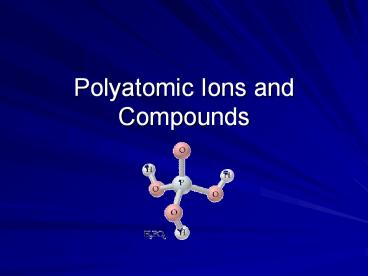Polyatomic Ions and Compounds - PowerPoint PPT Presentation
1 / 10
Title:
Polyatomic Ions and Compounds
Description:
Polyatomic Ions and Compounds Polyatomic Ion A group of atoms that tend to stay together and carry an overall ionic charge. Writing Formulas for Polyatomic Compounds ... – PowerPoint PPT presentation
Number of Views:374
Avg rating:3.0/5.0
Title: Polyatomic Ions and Compounds
1
Polyatomic Ions and Compounds
2
- Polyatomic Ion
- A group of atoms that tend to stay together and
carry an overall ionic charge.
1 -1 -2 -3
NH4 (ammonium) OH- (hydroxide) CO32- (carbonate) PO43- (phosphate)
NO3- (nitrate) SO42- (sulfate)
ClO3- (chlorate) CrO42- (chromate)
HCO3- (hydrogen carbonate or bicarbonate) Cr2O72- (dichromate)
MnO4- permanganate)
3
Writing Formulas for Polyatomic Compounds
- To write a chemical formula for a polyatomic
compound, follow these steps - 1. Write the symbols for each substance, with
the positive first. - 2. Write the ionic charge above each symbol.
- 3. Add more of the positive or negative ions
until the total charges are balanced. - 4. Write the formula using subscripts to
indicate the number of ions of each type.
4
For Example Sodium Sulfate
5
Example 2 Calcium Hydroxide
6
Naming Polyatomic Compounds
- To name a polyatomic compound,
- 1. The positive ion is named first
- 2. The negative ion is named second. Do not
change the ending of a polyatomic ion.
7
For example
- 1. Sodium and phosphate
- 2. Na CO3
- 3. K SO4
8
Multi Valent Nomenclature.
- Some transition metals have more than one valence
option. - Ex. Sn, Au, Pb, Fe.
- For determining the name you need to first look
at what it is paired with. - Ex. Fe2O3
- Oxygen has a ionic charge of -2 so in total there
is -6 as a charge for oxygen (3 x -2). Iron needs
to match so 2 x (3) will match it. Thus the
charge for iron MUST be 3 - Then we write the name with roman numerals
- Iron(III)oxide
9
Practice Questions
- Pg 151 1-8
10
Multi Valent Contd
- When you are given the name you read the roman
numerals to get the ionic charge of the element - Ex. Nickel (II) phosphate
- Ni has a charge of 2 according to the name
- Phosphate has a charge of (-3)
- The formula would be Ni3(PO4)2
- REMEMBERPolyatomic Ions are treated as a
unit. A subscript is put outside brackets to
have a consistent charge































